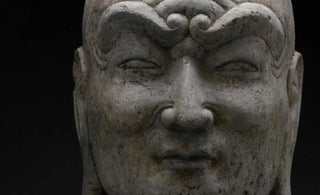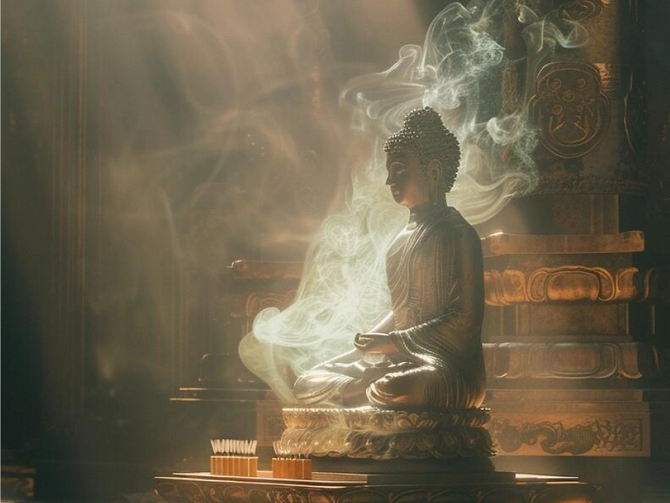
In the realm of classical oriental art, few creations captivate the imagination quite like the Grey Limestone Buddhas of the Tang Dynasty. These remarkable sculptures, crafted with meticulous attention to detail, hold profound symbolism and embody a deep sense of spirituality. In this article, we delve into the symbolism and spirituality behind the Grey Limestone Buddhas, shedding light on their significance and cultural impact.
The Significance of Grey Limestone Buddhas
Grey limestone, the medium chosen by the skilled craftsmen of the Tang Dynasty, holds a special place in the creation of the Grey Limestone Buddhas. This natural stone, with its smooth texture and subtle variations in color, lends itself perfectly to capturing the essence of serenity and enlightenment. Its inherent qualities imbue the sculptures with a sense of timelessness, as if the stone itself holds a secret waiting to be discovered. The serene expressions adorning the faces of the Grey Limestone Buddhas are perhaps the most striking aspect of these sculptures. The half-smiles and half-closed eyes convey a sense of tranquility and inner peace, inviting viewers to contemplate the nature of existence and the pursuit of spiritual awakening. These expressions symbolize a state of transcendence, serving as a reminder to detach oneself from the material world and seek enlightenment.
Mudras and Spiritual Gestures of Grey Limestone Buddhas
The Grey Limestone Buddhas of the Tang Dynasty not only captivate the eye with their serene expressions and flowing robes but also mesmerize with their intricate hand positions known as mudras. These mudras, symbolic gestures commonly found in Buddhist art, add another layer of depth to the symbolism and spirituality of the Grey Limestone Buddhas, offering profound insights into the teachings and practices of Buddhism. Mudras are sacred hand gestures that hold specific meanings and convey various aspects of spiritual enlightenment. Each mudra has its own significance and represents different qualities or states of being. The presence of mudras in the Grey Limestone Buddhas serves as a visual language, communicating profound spiritual teachings to those who observe and contemplate these sculptures.
One commonly seen mudra in the Grey Limestone Buddhas is the Dhyana Mudra, also known as the Meditation Mudra. This mudra is characterized by the placement of both hands resting on the lap, with the right hand placed on top of the left, and the thumbs gently touching. The Dhyana Mudra symbolizes inner stillness, concentration, and meditation. It represents the path to achieving a state of tranquility and connecting with one's inner self. Another significant mudra found in the Grey Limestone Buddhas is the Abhaya Mudra, the Gesture of Fearlessness. In this mudra, the right hand is raised with the palm facing outward, while the left hand rests by the side. The Abhaya Mudra represents protection, reassurance, and the dispelling of fear. It is a gesture of compassion and fearlessness, conveying the message that one should not be afraid in the face of adversity or the challenges of life.
The Varada Mudra, or the Gesture of Compassion and Giving, is yet another mudra frequently depicted in the Grey Limestone Buddhas. In this mudra, the right hand is extended downward with the palm facing outward, symbolizing the act of giving, generosity, and granting of wishes. The Varada Mudra represents the virtues of compassion, kindness, and the willingness to help others. It embodies the spirit of selflessness and charity, encouraging individuals to cultivate a compassionate heart and engage in acts of benevolence. Additionally, the Vitarka Mudra, or the Gesture of Teaching, holds special significance in Buddhist iconography. In this mudra, the thumb and index finger form a circle, symbolizing the transmission of knowledge and the teaching of the Dharma (the teachings of the Buddha). The Vitarka Mudra represents the act of sharing wisdom and understanding, emphasizing the importance of education, learning, and the dissemination of knowledge for the benefit of all beings.
The presence of these mudras in the Grey Limestone Buddhas not only adds visual beauty to the sculptures but also serves as a reminder of the path to spiritual awakening. Each mudra carries its own symbolism and imparts profound insights into the nature of reality, guiding practitioners and viewers alike on the journey towards enlightenment.
Cultural Impact and Legacy of Grey Limestone Buddhas
The Grey Limestone Buddhas of the Tang Dynasty have left an indelible mark on the cultural landscape of classical oriental art, transcending time and space to inspire artists, collectors, and enthusiasts around the world. These remarkable sculptures carry profound symbolism and spiritual resonance, fostering a deep appreciation for the beauty, wisdom, and cultural heritage of the Tang Dynasty. One of the significant cultural impacts of the Grey Limestone Buddhas is their role in the propagation and dissemination of Buddhist teachings. Buddhism, originating in ancient India, spread to East Asia during the Tang Dynasty and became deeply ingrained in Chinese culture. The Grey Limestone Buddhas served as powerful visual representations of Buddhist principles, making the teachings accessible to the masses and helping to popularize the faith. These sculptures became objects of veneration, inspiring devotion and providing a tangible connection to the spiritual realm.
Moreover, the Grey Limestone Buddhas reflect the artistic and technical achievements of the Tang Dynasty, often considered a golden age of Chinese art and culture. The exquisite craftsmanship and attention to detail in these sculptures showcase the mastery of Tang Dynasty artisans. Their ability to bring life to stone through the delicate rendering of facial expressions, flowing robes, and intricate ornaments is a testament to the artistic excellence of the era. The legacy of the Grey Limestone Buddhas extends beyond their physical forms. These sculptures carry within them the wisdom and teachings of Buddhism, serving as a reminder of the impermanence of life and the pursuit of spiritual enlightenment. They embody the core values of compassion, wisdom, and mindfulness, inspiring individuals to seek inner peace and cultivate a deeper understanding of themselves and the world around them.
Furthermore, the cultural impact of the Grey Limestone Buddhas can be seen in their influence on subsequent artistic traditions. Their distinctive style and iconography have influenced generations of artists across East Asia. The graceful poses, serene expressions, and symbolic motifs found in the Grey Limestone Buddhas have been replicated and reinterpreted in various art forms, from paintings and calligraphy to ceramics and sculpture. The enduring appeal and widespread recognition of these sculptures have contributed to the preservation and continuation of classical oriental art traditions. Today, the Grey Limestone Buddhas continue to inspire and captivate audiences worldwide. Their presence in museums, galleries, and private collections serves as a testament to their enduring relevance and cultural significance. These sculptures provide a gateway to understanding the rich spiritual and artistic heritage of the Tang Dynasty, fostering cross-cultural appreciation and dialogue.
























